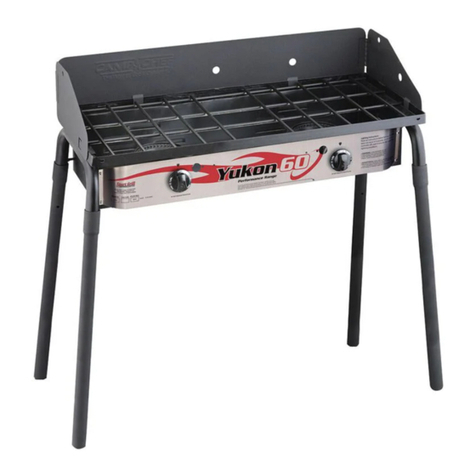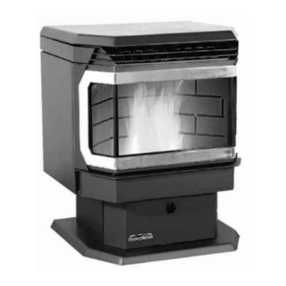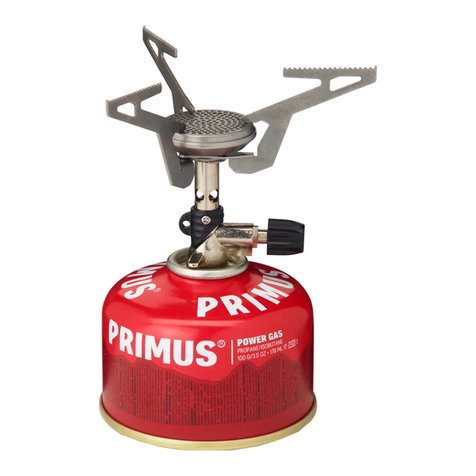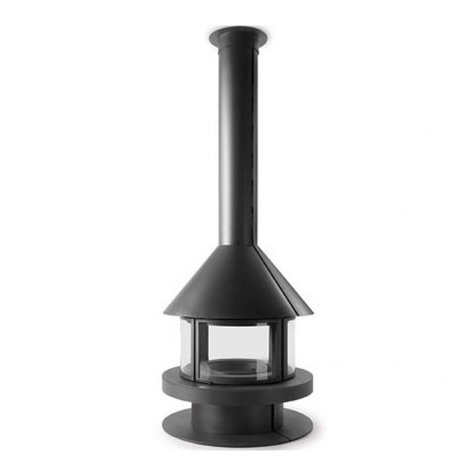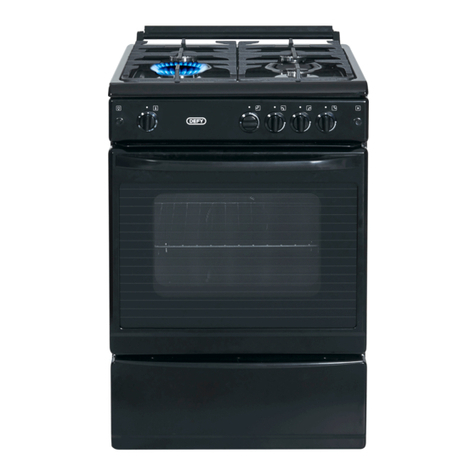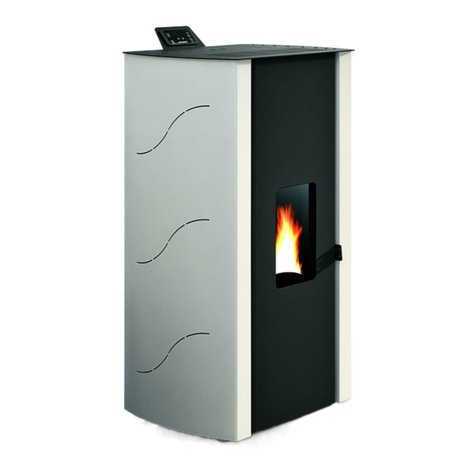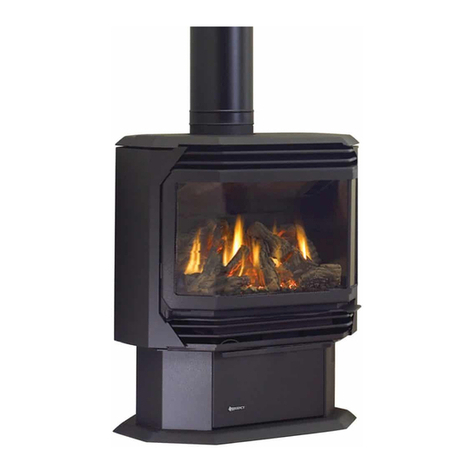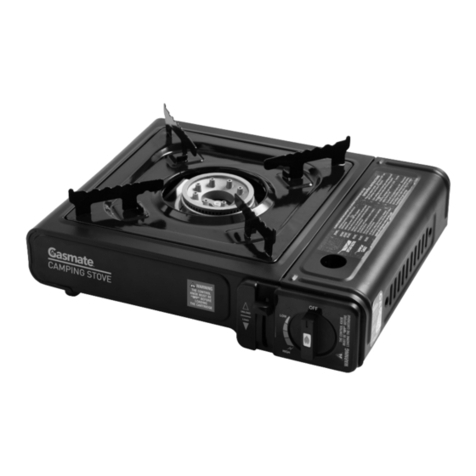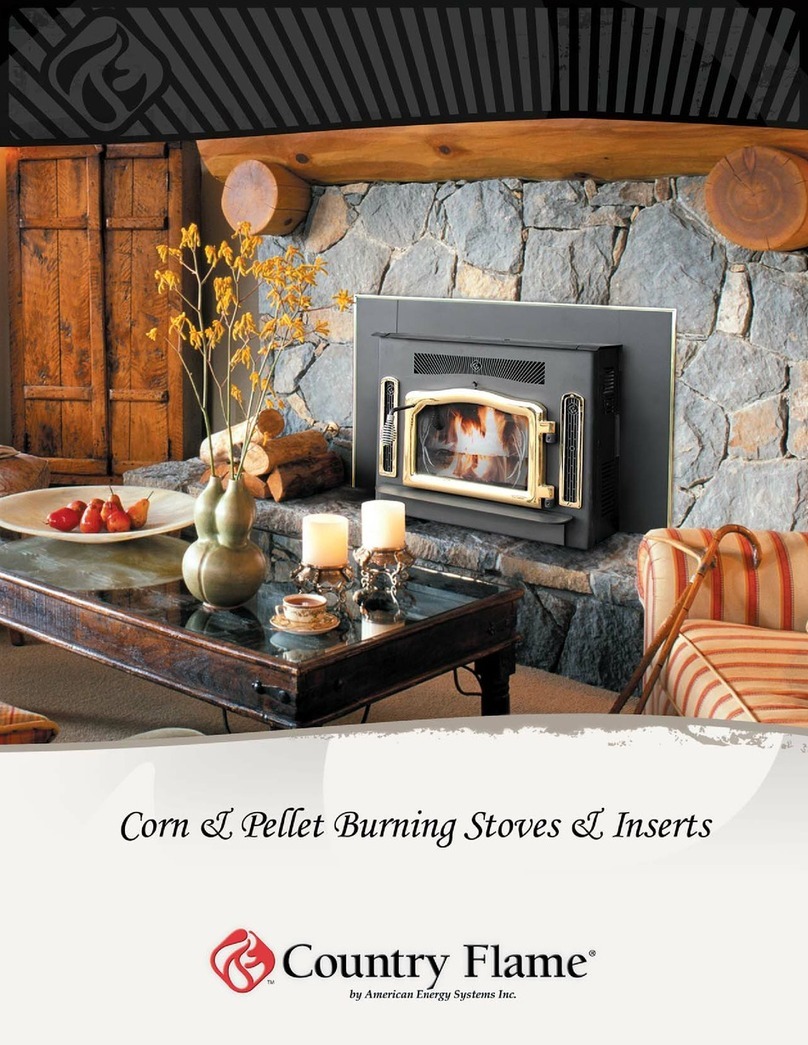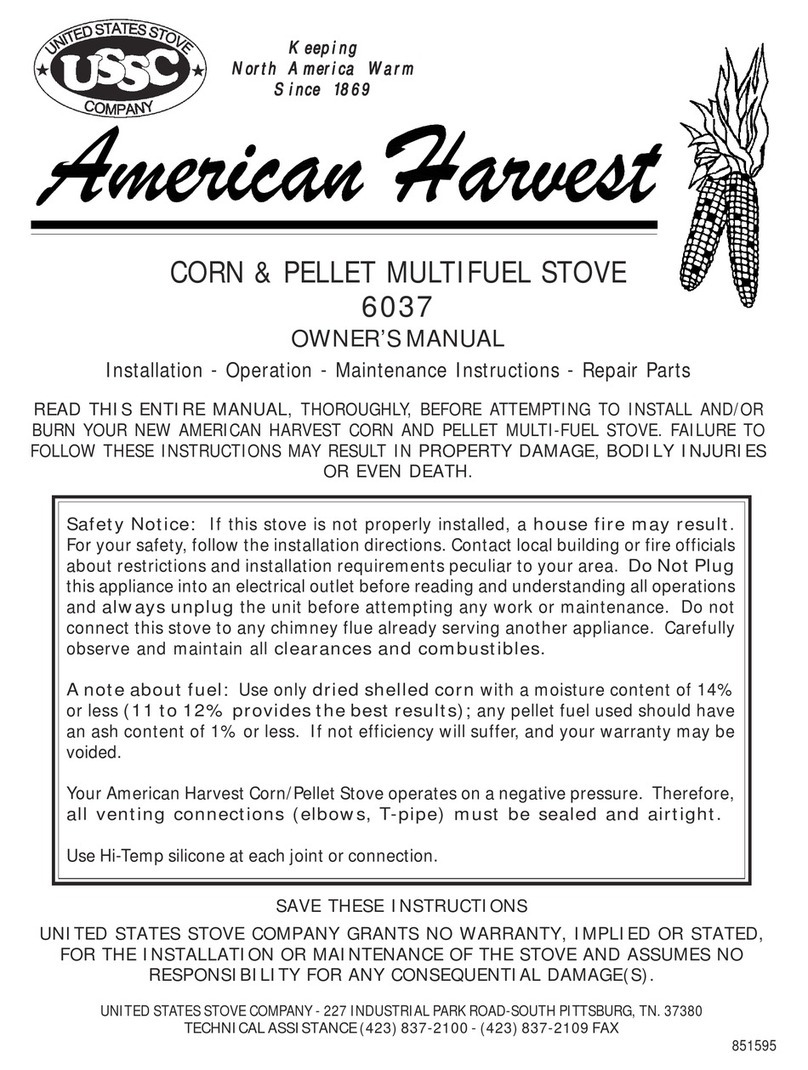ECO CHOICE ECO-ADV-PS35 User manual

1 7058-206E August 30, 2016
NOTICE: DO NOT DISCARD THIS MANUAL
Owner’s Manual
Operation & Care
INSTALLER: Leave this manual with party responsible for use and operation.
OWNER: Retain this manual for future reference.
Contact your dealer with questions on installation, operation, or service.
HOT SURFACES!
Glass and other surfaces are hot
during operation AND cool down.
Hot glass will cause burns.
• Do not touch glass until it is cooled
• NEVER allow children to touch glass
• Keep children away
• CAREFULLY SUPERVISE children in same room as
replace.
• Alert children and adults to hazards of high temperatures
• High temperatures may ignite clothing or other
ammable materials.
• Keep clothing, furniture, draperies and other ammable
materials away.
WARNING
If the information in these instruc-
tions is not followed exactly, a
re could result causing property
damage, personal injury, or death.
• Do not store or use gasoline or other am-
mable vapors and liquids in the vicinity of
this or any other appliance.
• Do not overre - If heater or chimney con-
nector glows, you are overring. Overring
will void your warranty.
• Comply with all minimum clearances to
combustibles as specied. Failure to
comply may cause house re.
WARNING
CAUTION
Tested and approved for wood pellets. Burning of any
other type of fuel voids your warranty.
NOTE
To obtain a French translation of this manual, please contact
your dealer or visit www.heatilator.com
Pour obtenir une traduction française de ce manuel, s’il vous
plaît contacter votre revendeur ou visitez www.heatilator.com
CAUTION
Check building codes prior to installation.
• Installation MUST comply with local, regional, state and na-
tional codes and regulations.
• Consult local building, re ofcials or authorities having juris-
diction about restrictions, installation inspection, and permits.
PELLET BURNING STOVES
Model(s):
ECO-ADV-PS35
ECO-ADV-PS50
ECO-CAB50

2 7058-206E August 30, 2016
HEATILATOR ECO CHOICE
CONFIDENTIAL PROPERTY OF HEARTH & HOME TECHNOLOGIES INC.
PART NAME:
DRAWN BY: SCALE: MATERIAL:
SHEET:
PART NUMBER: REV:
THIS PRINT IS CHECKED AND CONTROLLED BY THE ENGINEERING
DEPARTMENTS OF HEARTH & HOME TECHNOLOGIES INC.
ECO # DATE BY
REV
UNLESS OTHERWISE SPECIFIED DIMS ARE INCHES[MM] & : TOLERANCES ARE: (2) PLACE DEC : ± 0.03 (3) PLACE DEC: ± 0.005 ANGLE: ± 2° FRACTION: ± 1/16
OUTSIDE MATERIAL. NORMAL DIM & INSIDE MATERIAL. OUTSIDE APEX INSIDE APEX - DIMS ENCLOSED BY AN OVAL ARE CRITICAL DIMENSIONS
REVISIONS
ITEM PART NUMBER PART NAME QTY
D RECOMENDED IN USA; REQUIRED IN CANADA 67739 01/05/12 KV
E EPA CERTIFIED WAS EXEMPT, CORRECTED ADDRESS 74820 06/10/14 MCW
LABEL SERIAL ECO PS35
MCW NTS SEE NOTE
1 OF 1 7058-143 F
RELEASED
NOTE:
1. MATERIAL: NON-ANODIZED ALUMINUM 0.020 THICK
2. BACKGROUND: SILVER
3. COPY: BLACK / RED
4. ADHESIVE: N/A
5. TEMPERATURE RATING: -50°F TO 350°F
6. STARTING SERIAL NUMBER: 00701800000
F 2015 NSPS UPDATE 77522 05/04/15 MCW
9.88
7.00
U.S. ENVIRONMENTAL PROTECTION AGENCY
Certified to comply with 2015 particulate emission standards at 2.1 g/hr EPA method 28 and 5G. Not approved for sale after May 15, 2020.
This wood heater needs periodic inspection and repair for proper operation. Consult the owner’s manual for further information. It is against federal
regulations to operate this wood heater in a manner inconsistent with the operating instructions in the owner’s manual.
7058-143F
1445 North Highway
Colville, WA 99114
www.heatilator.com
*
Non-combustible floor protection must extend 2 inches
(51mm) beneath the flue pipe when installed with horizontal
venting or under the Top Vent Adapter with vertical installation.
RECOMMENDED IN USA; REQUIRED IN CANADA.
*Un protecteur incombustible de plancher doit s'étendre 2 inches (51mm)
sous le conduit de cheminée pour une installation de ventilation horizontale
ou sous un adapteur de ventilation de dessus pour une installation verticale.
ÉTATS-UNIS - RECOMMANDÉ; CANADA - REQUIRENT.
Floor protector must be non-combustible material, extending
beneath heater and to the front/sides/rear as indicated.
Measure front distance (I) from the surface of the glass door.
Le poêle doit être placé sur une assise non combustible s’étendant tout
autour de lui, comme les schémas l’indiquent. Mesurez la distance du
devant (I) de la surface de la porte vitrée.
2015 2016 2017 JAN FEB MAR APR MAY JUN JUL AUG SEP OCT NOV DEC
34,400 34,400
4001508
ECO-ADV-PS35
Conforms to ASTM STD E1509, Certified to ULC STD S627, ULC/ORD-C1482-M1990 Room
Heating Pellet Burning Type, (UM) 84-HUD FOR USE ONLY WITH PELLETIZED WOOD
FUEL. Do not use any other type of fuel.
B. Sample of Serial Number / Safety Label
LOCATION: Back of Stove
Serial No.
Test Lab &
Report No.
Model
Name
Mfg. Date
SAMPLE
A. Congratulations
Hearth & Home Technologies welcomes you to our tradition
of excellence! In choosing a Heatilator appliance, you have
our assurance of commitment to quality, durability, and per-
formance.
This commitment begins with our research of the market,
including ‘Voice of the Customer’ contacts, ensuring we
make products that will satisfy your needs. Our Research
and Development facility then employs the world’s most
advanced technology to achieve the optimum opera-
tion of our stoves, inserts and replaces. And yet we are
old-fashioned when it comes to craftsmanship. Each unit
is meticulously fabricated and gold and nickel surfaces are
hand-nished for lasting beauty and enjoyment. Our pledge
to quality is completed as each model undergoes a quality
control inspection.
We wish you and your family many years of enjoyment in the
warmth and comfort of your hearth appliance. Thank you for
choosing Heatilator.
NOTE: Clearances may only be reduced by means
approved by the regulatory authority having jurisdiction
and Welcome to the Quadra-Fire Family!

August 30, 2016 7058-206E 3
HEATILATOR ECO CHOICE
TABLE OF CONTENTS
Safety Alert Key:
• DANGER! Indicates a hazardous situation which, if not avoided will result in death or serious injury.
• WARNING! Indicates a hazardous situation which, if not avoided could result in death or serious injury.
• CAUTION! Indicates a hazardous situation which, if not avoided, could result in minor or moderate injury.
• NOTICE: Indicates practices which may cause damage to the appliance or to property.
A. Congratulations..................................................................2
B. Sample of Serial Number / Safety Label............................2
C. Warranty Policy .................................................................4
1 Listing and Code Approvals ............. 6
A. Appliance Certication ......................................................6
B. BTU & Efciency Specications........................................6
C. Glass Specications .........................................................6
D. Electrical Rating (on high) ................................................6
E. Mobile Home Approved .................................................... 6
2 Operating Instructions ...................... 7
A. Fire Safety .........................................................................7
B. Non-Combustible Materials ...............................................7
C. Combustible Materials.......................................................7
D. Fuel Material and Fuel Storage ........................................7
E. General Operating Information .........................................8
F. Before Your First Fire ........................................................8
G. Hopper Lid Latch and Hopper Switch...............................9
H. Starting Your First Fire .....................................................9
I. Fire Characteristics ............................................................10
J. Feed Rate Adjustment Instructions ...................................10
K. Ignition Cycles ..................................................................10
L. Clear Space ......................................................................10
M. Quick Start Guide..............................................................11
N. Frequently Asked Questions.............................................12
3 Maintenance and Service................ 13
A. Proper Shutdown Procedure ............................................13
B. Quick Reference Maintenance Chart................................13
C. General Maintenance .......................................................13
D. High Ash Fuel Content Maintenance.................................17
E. Soot or Creosote Fire .......................................................17
4 Troubleshooting Guide.................... 18
5 Service Parts Replacement............. 21
A. Convection Blower Replacement......................................21
B. Exhaust Blower Replacement...........................................22
C. Snap Disc Replacements .................................................22
D. Igniter Replacement .........................................................23
E. Bafe Removal & Replace................................................23
F. Glass Replacement ...........................................................24
6 Reference Materials......................... 25
A. Component Functions .......................................................25
B. Component Locations........................................................27
C. Exploded Drawings & Service Parts - PS35......................28
D. Exploded Drawings & Service Parts - PS50......................32
E. Exploded Drawings & Service Parts - CAB50 ...................36
Heatilator is a registered trademark of Hearth & Home Technologies.
NOTE: Hearth & Home Technologies, manufacturer of this appliance, reserves the right to alter its products,
their specications and/or price without notice.

4 7058-206E August 30, 2016
HEATILATOR ECO CHOICE
Warranty Period Heatilator ECO-CHOICE
Appliances Components Covered
Parts Labor Pellet EPA Wood
1 year X X All parts and material except as covered by
Conditions, Exclusions, and Limitations listed
3 years X Firepots and burnpots
3 years 1 year X X Castings
5 years 3 years X Manifold tubes
5 years 3 years X X Firebox and heat exchanger
90 days X X All replacement parts beyond warranty period
See conditions, exclusions,and limitations on next page
Page 1 of 2
Hearth & Home Technologies Inc.
HEATILATOR ECO-CHOICE WARRANTY
Hearth & Home Technologies Inc., on behalf of its hearth brands (“HHT”), extends the following warranty for ECO-
CHOICE by heatilator wood and pellet hearth appliances that are purchased from an HHT authorized dealer.
WARRANTY COVERAGE:
HHT warrantes to the original owner of the HHT appliance at the site of installation, and to any transferree taking own-
ership of the appliance at the site of installation within two years following the date of original purchase, that the HHT
appliance will be free from defects in materials and workmanship at the time of manufacture. After installation, if cov-
ered components manufactured by HHT are found to be defective in materials or workmanship during the applicable
warranty period, HHT will, at its option, repair or replace the covered components. HHT, at its own discretion, may fully
discharge all of its obligations under such warranties by replacing the product itself or refunding the veried purchase
price of the product itself. The maximum amount recoverable under this warranty is limited to the purchaser price of
the product. This warranty is subject to conditions, exclusions and limitations as described below.
WARRANTY PERIOD:
Warranty coverage begins on the date of original purchase. In the case of new home construction, warranty coverage
begins on the date of rst occupancy of the dwelling or six months after the sale of the product by an independent,
authorized HHT dealer/distributor, whichever occurs earlier. The warranty shall commence no later than 24 months
following the date of product shipment from HHT, regardless of the installation or occupancy date. The warranty period
for parts and labor for covered components is produced in the following table.
7014-212B 1-10-11
C. Warranty Policy

August 30, 2016 7058-206E 5
HEATILATOR ECO CHOICE
WARRANTY COVERAGE:
• This warranty only covers HHT appliances that are purchased through an HHT authorized dealer or distributor. A list of
HHT authorized dealers is available on th HHT branded websites.
• This warranty is only valid while the HHT appliance remains at the site of original installation.
• Contact your installing dealer for warranty service. If the installing dealer is unable to provide necessary parts, contact
the nearest HHT authorized dealer or supplier. Additional service fees may apply if you are seeking warranty service
from a dealer other than the dealer from whom you originally purchased the product.
• Check with your dealer in advance for any costs to you when arranging a warranty call. Travel and shipping charges
for parts are not covered by this warranty.
WARRANTY EXCLUSIONS:
This warranty does not cover the following:
• Changes in surface nishes as a result of normal use. As a heating appliance, some changes in color of interior and
exterior surface nishes may occur. This is not a aw and is not covered under warranty.
• Damage to printed, plated, or enameled surfaces caused by ngerprints, accidents, misuse, scratches, melted items,
or other external sources and residues left on the plated surfaces from the use of abrasive cleaners or polishes.
• Repair or replacment of parts that are subject to normal wear and tear during the warranty period. These parts include:
paint, wood, pellet and coal gaskets; rebricks; grates; ame guides; light bulbs; batteries and the discoloration of
glass.
• Minor expansion, contraction, or movement of certain parts causing noise. These conditions are normal and com-
plaints related to this noise are not covered by this warranty.
• Damages resulting from: (1) failure to install, operate, or maintain the appliance in accordance with the installation
instructions, operating instructions, and listing agent identication label furnished with the appliance; (2) failure to
install the appliance in accordance with local building codes; (3) shipping or improper handling; (4) improper operation,
abuse, misuse, continued operation with damaged, corroded or failed components, accident, or improperly/incorrectly
performed repairs; (5) environmental conditions, inadequate ventilation, negative pressure, or drafting caused by tightly
sealed constructions, insufcient make-up air supply, or handling devices such as exhaust fans or forced air furnaces
or other such causes; (6) use of fuels other than those specied in the operating instructions; (7) installation or use of
components not supplied with the appliance or any other components not expressly authorized and approved by HHT;
(8) modication of the appliance not expressly authorized and approved by HHT in writing; and/or (9) interruptions or
uctuations of electrical power supply to the appliance.
• Non-HHT venting components, hearth components or other accessories used in conjunction with the appliance.
• Any part of a pre-existing replace system in which an insert or a decorative gas appliance is installed.
• HHT’s obligation under this warranty does not extend to the appliances’ capability to heat the desired space. Informa-
tion is provided to assist the consumer and the dealer in selecting the proper appliance for the application. Consider-
ation must be given to appliance location and conguration, environmental conditions, insulation and air tightness of
the structure.
This warranty is void if:
• The appliance has been over-red or operated in atmospheres contaminated by chlorine, uorine, or other damaging
chemicals. Overring can be identied by, but not limited to, warped plates or tubes, rust colored cast iron, bubbling,
cracking and discoloration of steel or enamel nishes.
• The appliance is subjected to prolonged periods of dampness or condensation.
• There is any damage to the appliance or other components due to water or weather damage which is the result of, but
not limited to improper chimney or venting installation.
WARRANTY EXCLUSIONS:
• The owner’s exclusive remedy and HHT’s sole obligation under this warranty, under any other warranty, express or
implied, or in contract, tort or otherwise, shall be limited to replacement, repair, or refund, as specied above. In no
event will HHT be liable for any incidiental or consequential damages caused by defects in the appliance. Some states
do not allow exclusions or limitation of incidental or consequential damages, so these limitations may not apply to you.
This warranty gives you specice rights; you may also have other rights, which vary from state to state. EXCEPT TO
THE EXTENT PROVIDED BY LAW, HHT MAKES NO EXPRESS WARRANTIES OTHER THAN THE WARRANTY
SPECIFIED HEREIN. THE DURATION OF ANY IMPLIED WARRANTY IS LIMITED TO DURATION OF THE EX-
PRESSED WARRANTY SPECIFIED ABOVE.
Page 2 of 2
7014-212B 1-10-11

6 7058-206E August 30, 2016
HEATILATOR ECO CHOICE
Model ECO-ADV-PS35, ECO-ADV-PS50
and ECO-CAB50
Laboratory Intertek
Report No. 4001508
Type Solid Fuel Room Heater/Pellet Fuel
Burning Type
Standard ASTM E1509-04 and ULC S627-00,
ULC/ORD-C1482-M1990 Room Heater
Pellet Fuel Burning type and (UM) 84-
HUD, Mobile Home Approved.
FCC Complies with Part 15 of FCC Rules.
Operation is subject to the following
two conditions: (1) this device may not
cause harmful interference, and (2) this
device must accept any interference
received, including interference that may
cause undesired operation.
B. BTU & Efciency Specications
1 Listing and Code Approvals
A. Appliance Certication
NOTICE: This installation must conform with local codes. In
the absence of local codes you must comply with the ASTM
E1509-04, ULC S627-00, (UM) 84-HUD and ULC/ORD-
C-1482.
Improper installation, adjustment, alteration, service or
maintenance can cause injury or property damage.
For assistance or additional information, consult a qualied
installer, service agency or your dealer.
• Installation and use of any damaged appliance.
• Modication of the appliance.
• Installation other than as instructed by Hearth & Home
Technologies.
• Installation and/or use of any component part not approved by
Hearth & Home Technologies.
• Operating appliance without fully assembling all components.
• Operating appliance without legs attached (if supplied with unit).
• Do NOT Overre - If appliance or chimney connector glows,
you are overring.
Any such action that may cause a re hazard.
WARNING
Fire Risk.
Hearth & Home Technologies disclaims any
responsibility for, and the warranty will be voided by,
the following actions:
C. Glass Specications
This stove is equipped with 5mm ceramic glass. Replace
glass only with 5mm ceramic glass. Please contact your
dealer for replacement glass.
D. Electrical Rating (on high)
Model PS35: 115 VAC, 60 Hz, Start 3.8 Amps, Run 1.3 Amps
Model PS50: 115 VAC, 60 Hz, Start 5.1 Amps, Run 3.0 Amps
Model CAB50: 115 VAC, 60 Hz, Start 5.1 Amps, Run 3.0 Amps
E. Mobile Home Approved
• This appliance is approved for mobile home installa-
tions when not installed in a sleeping room and when
an outside combustion air inlet is provided.
• The structural integrity of the mobile home oor, ceil-
ing, and walls must be maintained.
• The appliance must be properly grounded to the frame
of the mobile home and use only Listed pellet vent
Class “L” or “PL” connector pipe.
• Outside Air Kit, part OAK-ACC must be installed in a
mobile home installation.
• Unit must be secured to mobile home structure.
Note: The appliance is also approved for installation
into a shop
PS35 PS50
CAB50
EPA Certication #: 937-14 938-14
EPA Certied Emissions: 2.1 1.7 grams/hour
*LHV Tested Efciency: N/A N/A %
**HHV Tested Efciency: N/A N/A %
***EPA BTU Output: 9,300 to
24,400
11,900 to
31,400
per hr.
****BTU Input: 12,900 to
34,400
16,300 to
43,000
per hr.
Vent Size: 3 or 4 inches, “L” or “PL”
Hopper Capacity: 45 83/120 lbs.
Fuel Wood Pellets
* Weighted average LHV efciency using data collected during
EPA emissions test.
**Weighted average HHV efciency using data collected during
EPA emissions test.
***A range of BTU outputs based on EPA Default Efciency and
the burn rates from the low and high EPA tests.
****Based on the maximum feed rate per hour multiplied by
approximately 8600 BTU’s which is the average BTU’s from a
pound of pellets.
The Heatilator ECO Choice Pellet Heater meets the U.S. Environ-
mental Protection Agency’s emission limits for pellet heaters sold
after May 15, 2015.
This pellet heater needs periodic inspection and repair for proper
operation. It is against federal regulations to operate this pellet heater
in a manner inconsistent with operating instructions in this manual.

August 30, 2016 7058-206E 7
HEATILATOR ECO CHOICE
User Guide
2 Operating Instructions
A. Fire Safety
To provide reasonable re safety, the following should be
given serious consideration:
• Install at least one smoke detector and CO monitor on each
oor of your home.
• Locate detectors away from the heating appliance and close
to the sleeping areas.
• Follow the detector’s manufacturer’s placement and
installation instructions and maintain regularly.
• Conveniently locate a Class A re extinguisher to contend
with small res.
• In the event of a hopper re:
• Evacuate the house immediately.
• Notify re department.
B. Non-Combustible Materials
Material which will not ignite and burn, composed of any
combination of the following:
- Steel - Plaster - Glass - Tile
- Brick - Iron - Slate - Concrete
Materials reported as passing ASTM E 136, Standard
Test Method for Behavior of Metals, in a Vertical Tube
Furnace of 750° C.
C. Combustible Materials
Material made of/or surfaced with any of the following
materials:
- Compressed Paper - Wood - Plywood/OSB
- Sheet Rock (drywall) - Plastic - Plant Fibers
Any material that can ignite and burn: ame proofed or not,
plastered or un-plastered.
D. Fuel Material and Fuel Storage
Pellet fuel quality can greatly uctuate. This appliance has
been designed to burn a wide variety of fuels, giving you the
choice to use the fuel that is most economical in your region.
Hearth & Home Technologies strongly recommends only using
Pellet Fuel Institute (PFI) certied fuel.
Fuel Material
• Made from sawdust or wood by-products
• Depending on the source material it may have a high or
low ash content.
Higher Ash Content Material
• Hardwoods with a high mineral content
• Fuel that contains bark
• Standard grade pellets, high ash pellets,
Lower Ash Content Material
• Softwoods
• Fuels with low mineral content
• Premium grade pellets
Clinkers
Minerals and other non-combustible materials such as sand
will turn into a hard, glass-like substance called a clinker when
heated in the repot.
Trees from different areas will vary in mineral content. That
is why some fuels produce more clinkers than others.
Moisture
Always burn dry fuel. Burning fuel with high moisture content
takes heat from the fuel and tends to cool the appliance,
robbing heat from your home. Damp pellet fuel can clog the
feed system.
Size
•
Pellets are either 1/4 inch or 5/16 inch (6-8mm) in diameter
• Length should be no more that 1-1/2 inches (38mm)
• Pellet lengths can vary from lot to lot from the same
manufacturer
• Due to length variations, the ame height (feed rate) may
need adjusting occasionally. See page 10 for instructions.
Performance
• Higher ash content requires the ash drawer to be emptied
more frequently
• Hardwoods require more air to burn properly
• Set wall control to “Utility Pellet” if the repot and ash pan
are lling quickly. This will cause the auto-clean system
to empty the repot more often.
• Premium wood pellets produce the highest heat output.
• Burning pellets longer than 1-1/2 inches (38mm) can cause
an inconsistent fuel feed rate and/or missed ignitions.
We recommend that you buy fuel in multi-ton lots whenever
possible. However, we do recommend trying various brands
before purchasing multi-ton lots to ensure your satisfaction.
Fire Risk.
• Do not operate appliance before reading and
understanding operating instructions.
• Failure to operate appliance properly may
cause a house re.
WARNING

8 7058-206E August 30, 2016
HEATILATOR ECO CHOICE
HOT WHILE IN OPERATION. KEEP CHILDREN, CLOTHING
AND FURNITURE AWAY. CONTACT MAY CAUSE SKIN
BURNS.
CAUTION
Changing to Different Fuel Type
• Empty the hopper of the previous fuel
•
Thoroughly vacuum hopper before lling with the new fuel
• Select the appropriate setting on the FUEL SELECTION
screen on the thermostat wall control
The burn rate, BTU content and heat output will all vary
depending on the fuel selected.
Storage
• Wood pellets should be left in their original sealed bag until
using to prevent moisture absorption.
• This will also prevent rodents from becoming a problem
.
• Do not store any pellet fuel within the clearance requirements
or in an area that would hinder routine cleaning and
maintenance.
E. General Operating Information
1. Thermostat Calls For Heat
The appliance is like most modern furnaces; when the
thermostat calls for heat, your appliance will automatically
light and deliver heat.
When the room is up to temperature and the thermostat is
satised, the red call light will go off and the appliance will
shut down.
2. Heat Output Controls
This appliance is equipped with a heat output control switch
that has three settings or burn rates; low, medium and high.
Figure 8.1.
The appliance will turn on and off as the thermostat demands.
When the thermostat calls for heat, the appliance will start
up at the burn rate for which it is set. If the appliance is set
at one of the lower settings, it will run quieter but take longer
to heat up an area than if it were set at a higher burn rate.
Regardless of the burn rate, when the area is warm enough
to satisfy the thermostat, the appliance will shut off.
Tested and approved for wood pellets. Burning of any
other type of fuel voids your warranty.
CAUTION
Figure 8.1
F. Before Your First Fire
1. First, make sure your appliance has been properly
installed and that all safety requirements have been met.
Pay particular attention to the re protection, venting and
thermostat installation instructions.
2. Double check that the ash drawer and rebox are empty!
3. Check that cleaning rod is in the fully closed
position.
4. Close and latch the door.
NOTICE: The tip of the thermocouple must be in contact
with the inside end of the thermocouple cover or missed
ignitions can occur.

August 30, 2016 7058-206E 9
HEATILATOR ECO CHOICE
Hopper Lid Latch
Hopper Switch
Push Bottom of Latch
Inward to Release
G. Hopper Lid Latch and Hopper Switch
1. Lift up the hopper lid and lock into open position. Now
you can ll the hopper with fuel.
2. The hopper switch is designed to shut down the feed
motor when the hopper lid is open. Leaving the lid open
too long can cause the re to go out. Figure 9.1.
3. To close the hopper lid, while holding lid open with one
hand, push the bottom of the latch inwards to release
from locked position and then slowly close the hopper
lid. Figure 9.2.
Note: The CAB50 has no hopper lid latch. The hopper switch
is located in a similar location and is activated by a magnet
attached to the Hopper Lid.
Figure 9.1
Figure 9.2
H. Starting Your First Fire
1. A thermostat is required for proper operation of this
appliance. If you have to adjust the feed rate after you
have started the re, most of the pellets in the hopper will
need to be removed so start out with lling the hopper
approximately 1/4 full at this time. Set the thermostat to
its lowest setting and plug the power cord into nearby
outlet.
2. The exhaust blower will stay on for approximately 18
minutes even though the thermostat is not calling for heat.
This is normal.
3. L
ocate the heat output control switch mounted on the back
of the appliance in the upper left corner. Figure 8.1 on
page 8.
Turn it to the “high” setting by pushing the top of the
control switch in and then adjust the thermostat to its
highest setting.
4. Look through the hole in the left lower side panel and you
will see the red call light on the control box will be on.
Figure 9.3. This indicates the thermostat is calling for
heat. On the CAB50 the light can be viewed from behind
through the hole near the bottom left side of the rear panel.
5.
The fuel feed system and the igniter should
now
be on.
6. For your rst re it will be necessary to press the reset
button once approximately 2 minutes after start up and
again in 5 minutes. Reset as needed or every 60 seconds
until pellets begin to drop into repot. This will ll the feed
system and allow the appliance to begin dropping pellets.
Or you can put a handful of pellets in the repot to speed
up the process. The appliance will continue to run as long
as the thermostat is calling for heat.
7. Once the appliance has ignited, let it burn for approximately
15 minutes, then set the thermostat to the desired room
temperature. Adjust the heat output control switch to the
desired setting.
Figure 9.3
Control Box
Junction Box
Red Call Light
Fuse
Convection
Blower
LOCATED BEHIND LEFT SIDE PANELS
Odors and vapors released during initial operation.
• Curing of high temperature paint.
• Open windows for air circulation.
Odors may be irritating to sensitive individuals.
CAUTION

10 7058-206E August 30, 2016
HEATILATOR ECO CHOICE
I. Fire Characteristics
A properly adjusted re with the heat output control switch
set on “high” has a short active ame pattern that extends out
of the repot approximately 4 to 8 inches (102 to 203mm).
If the re has tall ames with black tails and seems somewhat
lazy, the feed rate will need to be reduced. This is done by
sliding the fuel adjustment control rod down, which will reduce
the feed. Figure 10.2.
If the re is not 4 to 8 inches (102 to 203mm) tall, slide the
fuel adjustment control rod up to increase the feed. A medium
and low setting will give a shorter ame. The ame will rise
and fall somewhat. This is normal.
J. Feed Rate Adjustment Instructions
1. Loosen the thumb screw.
2. Pull the feed adjustment control rod up to increase the
feed rate and ame height or push down to decrease the
feed rate and ame height.
3. Re-tighten the thumb screw. A new stove has a break in
period. The re characteristics should be checked again after
5 bags of pellets and adjustments made if necessary.
Figure 10.1
Feed Adjustment Rod located
inside Hopper at Front
Bottom of Hopper
Loosen Thumb Screw
Pull Up to
Increase
Push Down to
Decrease
Figure 10.2
K. Ignition Cycles
1. At the beginning of each ignition cycle, it is normal to see
some smoke in the rebox. The smoke will stop once
the re starts.
2. The convection blower will automatically turn on after your
appliance has been burning for approximately 10 minutes.
This blower transfers heat from your appliance into the
room, and will continue to run after the thermostat has
stopped calling for heat until the appliance has cooled
down.
3. Occasionally the appliance may run out of fuel and shut
itself down. When this happens, the red call light will be
on. See Figure 9.3, page 9.
To restart it, ll the hopper and press the reset button.
When you press the reset button the red call light will go
out. Release the button and the light will come back on.
Continue pushing the button once a minute until pellets
begin to fall into the repot.
You should see a re shortly. If not, follow the instructions
on page 9, for “Starting Your First Fire”.
L. Clear Space
Mantel:
Avoid placing candles and other heat-sensitive
objects on mantel or hearth. Heat may damage these
objects.
NOTICE: Clearances may only be reduced by means ap-
proved by the regulatory authority having jurisdiction.
Fire Risk.
Keep combustible materials, gasoline and other
ammable vapors and liquids clear of appliance.
• Do NOT store ammable materials in the appliance’s
vicinity.
• DO NOT USE GASOLINE, LANTERN FUEL, KEROSENE,
CHARCOAL LIGHTER FLUID OR SIMILAR LIQUIDS TO
START OR “FRESHEN UP” A FIRE IN THIS HEATER.
•DO NOT BURN GARBAGE OR FLAMMABLE FLUIDS
SUCH AS GASOLINE, NAPHTHA OR ENGINE OIL.
•DO NOT USE CHEMICALS OR FLUIDS TO START THE
FIRE.
• Keep all such liquids well away from the heater while it is in
use.
• Combustible materials may ignite.
WARNING
Fire Risk.
Do NOT place combustible objects in front of the
appliance. High temperatures may ignite clothing,
furniture or draperies. Maintain a minimum clear-
ance of 3 feet (914mm) in front of appliance.
WARNING

August 30, 2016 7058-206E 11
HEATILATOR ECO CHOICE
M. Quick Start Guide
ECO CHOICE QUICK START GUIDE
*Before you plug in this appliance, follow these instructions*
Once a re has been established
in the unit, leave the unit burning
on the “high” setting for 30 min-
utes to allow the paint to cure.
Note: Odors and vapors will be
released during this process.
*Open windows in the room for
ventilation*
12
456
9
Remove hang tags from the door glass. Clean the glass. Remove the hardware pack and
dessicant bag from the rebox area before your rst re.
Add pellets to the hopper and
close the lid.
Open the rebox door and make
sure the baf es are in place.
Close the rebox door and plug
the power cord into the wall
receptacle.
Turn the thermostat on.
Turn the thermostat to off.
If the feed tube is empty or this
is the rst re, add a handful of
pellets to the repot.
*Do not add extra fuel to the
repot if the feed tube has already
been primed. Over lling the re-
pot will cause smoky start-ups.
If the re dies out after a few
minutes of operation it will be nec-
essary to push the reset button to
add more fuel.
3
7
The stove will feed pellets for
a minute and stop. Once a re
starts, the feed cycle will resume.
Note: Allow 5 minutes for
ignition to take place.
8
After 30 minutes have passed, turn the thermostat off and allow the unit to cool completely. Open the door and
clean the repot according to the cleaning instructions found inside the hopper lid or owners manual. Close the
door and set the thermostat to a desired temperature. Unit is now ready to resume normal operation.
10

12 7058-206E August 30, 2016
HEATILATOR ECO CHOICE
N. Frequently Asked Questions
CONTACT YOUR DEALER for additional information
regarding operation and troubleshooting.
Visit www.heatilator.com to nd a dealer.
What causes my glass to become dirty?
If the glass has white ash build up it is normal and the
glass should be cleaned. If it is a black soot build up airow
thru the unit may be restricted. The most often cause is
overdue maintenance and cleaning. See “Maintaining and
Servicing Appliance” in the owner’s manual.
How can I get more heat out of the appliance?
The most often cause of diminished heat output is overdue
maintenance and cleaning . See “Maintaining and Servic-
ing Appliance” in the owner’s manual. If this still does not
help, verify the correct settings for maximum heat output.
See “Feed Rate Adjustment” under “Operating Instructions”
in the owner’s manual.
What should I do if I smell smoke or there is ash/soot
coming from the appliance?
While there will always be some smoke smell from wood
burning appliances (including pellet) you should investigate
all venting to make sure it is sealed properly. Most vent-
ing requires silicone to seal the seams. In addition most
homes are built very tight today and with exhaust systems
can create negative pressure in the home. See “Negative
Pressure” under “Getting Started” in the owner’s manual if
you have checked the venting but still have smoke coming
from the appliance. For ash or soot check the above and
the exhaust blower housing and seals.
Why would my appliance run ne last winter but not
start this fall?
It is possible that the stove was not properly prepared for
the Non-burn season. See “Trouble shooting” in the own-
er’s manual.
Why would the metal on the inside of the appliance
begin to ake?
There are some pellet mills that get their raw materials
from lumber mills that purchase logs that are transported
in sea water. These pellets can have a higher salt content
and cause the metals in the unit to corrode prematurely
and deteriorate. If you are seeing any components inside
the rebox deteriorate it is recommended to change pellet
brands immediately.
Why does only the exhaust blower run when I unplug
and plug back in my appliance?
This is a Safety feature to prevent the unit from operating in
an unsafe condition. Allow the unit to run and it will return to
normal operation.
Is there a place to lubricate the blowers to quiet them
down?
The most often cause of noisy blowers is from the impellers
becoming dirty over time. See “General Maintenance &
Cleaning” under “Maintaining & Servicing Appliance” in the
owner’s manual. No form of lubrication should ever need
applied to the blowers.
Why are different components cycling on and off in my
appliance at random?
The selector switch on control box may be on the wrong
setting. Refer to the Reference Materials section of our
owner’s manual for details.
What is the metal object with the bend in it for that
came inside the plastic bag?
It is a clean-out tool used to help clean the repot and
remove any jams in the rare event they occur in the feed
tube.
Why is there a black residue building up on the outside
of my home?
Wind can cause this to happen. If the appliance is operat-
ing correctly very little soot should ever exit the termination
cap. Also check to be sure the venting is installed per the
owner’s manual and local codes.
Do I need an outside air kit?
Outside air is required for mobile home installs and in
some jurisdictions. Refer to “Listing & Code Approvals”,“
Mobile Home Installation” and “ Appliance Set-up” owner’s
manual. Also refer to local building codes.
I am seeing sparks coming out of my pipe (termination
cap) outside is this safe?
This is normal. As long as clearances to combustibles
were followed this is safe.
My unit sounds like a freight train at times what can be
done to eliminate this?
This is referred to as Rumbling. Maintenance may be
needed see “Maintaining and Servicing appliance” in the
owner’s manual. Decrease fuel ow see “Feed rate adjust-
ment” under Operating Instructions”.
Why does my unit run ne on high, but shuts down on
low and medium?
Maintenance may be needed see “Maintaining and Servic-
ing Appliance” See also “Trouble Shooting”.
Can I use another brand of wall thermostat or remote
system?
Yes, any remote/wall thermostat system that does not
require power from the appliance should work.
I have no power to anything. Does this unit have a
circuit breaker or fuse or a reset button?
This unit has one serviceable fuse in the junction box and
a reset button for the thermostat circuit.
Can I burn corn in my unit?
Corn is not an approved fuel for the ECO units.
I’m thinking about going green (solar power) and need
to know what the power consumption is on my Unit.
PS50 115 VAC, 60 Hz, Start 5.1 Amps, Run 3.0 Amps.
PS35 115 VAC, 60 Hz, Start 3.8 Amps, Run 1.3 Amps.
CAB50 115 VAC, 60 Hz, Start 5.1 Amps, Run 3.0 Amps
Where is the serial # of my unit is located?
The serial # is located on the back of the stove.

August 30, 2016 7058-206E 13
HEATILATOR ECO CHOICE
3 Maintenance and Service
C. General Maintenance
1. Types of Fuel
Depending on the type of fuel you are burning will dictate how
often you have to clean your repot.
If the fuel you are burning has a high dirt or ash content, it
may be necessary to clean the repot more than once a day.
Dirty fuel will cause clinkers to form in the repot. A clinker
is formed when dirt, ash or a non-burnable substance is
heated to 2000°F (1093°C) and becomes glass-like. See
“D” page 17 in this section for more details on fuels with
high ash content.
Clinker
Figure 13.1 - Clinker
Shock and Smoke Hazard
• Turn down thermostat, let appliance completely
cool and exhaust blower must be off. Now you
can unplug appliance before servicing.
• Smoke spillage into room can occur if appliance
is not cool before unplugging.
• Risk of shock if appliance not unplugged before
servicing appliance.
CAUTION
Cleaning or Inspection Frequency Daily Weekly Monthly Yearly
Ash Drawer Every 5 bags of fuel OR X
Ash Removal from Firebox Every 5 bags of fuel or more
frequently depending on ash
build-up
OR
X
Blower, Exhaust More frequently depending on
the fuel type
OR X
Blower, Convection Every 25 bags or more fre-
quently depending on operat-
ing environment.
OR
X
Door Handle & Gasket Inspection Prior to heating season OR X
Exhaust Path, Drop Tube and Behind
Bafes
Every 25 bags or more fre-
quently depending on ash
build-up
OR
X
Firepot Cleaning Rod Every 1 bag of fuel OR X
Firepot with Clean-out Tool Every 5 bags of fuel OR X
Firebox - Prepare for Non-Burn Season At end of heating season OR X
Glass When clear view of repot
becomes obscure
OR X
Hopper Every 50 bags of fuel OR X
Top Vent Adapter More frequently depending on
ash build-up
OR X
Venting System Every 3 tons or more fre-
quently depending on the fuel
type
OR
X
B. Quick Reference Maintenance Chart
Follow the detailed instructions found in this
section for each step listed as referenced in
the chart below.
NOTICE: These are recommendations. Clean more frequently if you encounter heavy build-up of
ash at the recommended interval or you see soot coming from the vent. Not properly
cleaning your appliance on a regular basis will void your warranty.
A. Proper Shutdown Procedure
This pellet heater has a manufacturer-set minimum low burn
rate that must not be altered. It is against federal regulations
to alter this setting or otherwise operate this pellet heater in a
manner inconsistent with operating instructions in this manual.

14 7058-206E August 30, 2016
HEATILATOR ECO CHOICE
3. Ash Removal from Firebox
• Frequency: Weekly or more frequently depending on
ash build-up.
• By: Homeowner
a. There must not be any hot ashes in the rebox during
cleaning so allow the appliance to completely cool. The
rebox ash should be removed every time the exhaust
path is cleaned. Frequent cleaning of the ash in the
rebox will help slow down the build-up of ash in the
exhaust blower and vent system.
b. Vacuum out the rebox thoroughly on both sides of
the rebox and the oor and ceiling. The ash drawer
should be emptied every time you clean the rebox.
Remember to place the ash and debris into a metal or
non-combustible container. See Disposal of Ashes.
(Pg 15)
c. Always have the ash drawer in place before pulling the
repot cleaning rod, otherwise the ashes will fall down
and ll the outside air opening and the appliance will
produce soot out of the exhaust and will affect efciency.
2. Cleaning Firepot with Cleaning Rod & Firepot
Clean-Out Tool;
• Frequency: Daily or more often as needed
• By: Homeowner
a. The appliance must be in complete shutdown and cool
and the exhaust blower off. If you are just cleaning the
repot, there is no need to unplug the appliance.
b. Locate the repot cleaning rod on the right side of the
appliance. Figure 14.1. When you pull the cleaning
rod straight out it will slide open the repot oor to allow
the ashes to be deposited in the ash drawer. You will
see the light color painted area on the cleaning rod to
let you know the rod is in OPEN position. Figure 14.2.
c. Pull the repot cleaning rod OUT and IN a couple of
times to help shake debris loose. If the rod is hard to
pull, it may be necessary to use your repot clean-out
tool to chip away material that has built up on the bottom
plate of the repot and to push out any clinkers while
in the open position.
d. To close the repot oor: slightly raise the cleaning
rod and then push it back into place. If you have closed
the cleaning rod properly (pushed all the way in) you
will not see any of the light color painted area. Figure
14.2.
e. Always have the ash drawer in place before pulling the
repot cleaning rod, otherwise the ashes will fall down
and ll the outside air opening and the appliance will
produce soot out of the exhaust and will affect efciency.
Firepot Cleaning Rod
Figure 14.1
Figure 14.2
CLOSED Position
No light color paint is visible
Lift up and push closed
OPEN Position. Light color
painted area visible
WARNING
Fire Risk
• NEVER pull repot cleaning rod out when appliance is
operating.
• Cleaning Rod MUST be completely pushed in before
operating appliance.
•. Hot pellets may fall into ashpan and start a re or mis-starts
due to lack of vacuum.
WARNING
Burn Risk
• NEVER remove ash drawer while appliance is operat-
ing.
4. Cleaning Ash Drawer
• Frequency: Weekly or every 5 bags of fuel
• By: Homeowner
a. There must not be any hot ashes in the ash drawer when
you empty it, so allow the appliance to completely cool.
b. Locate the ash drawer underneath the repot. Slide the
ash drawer straight out. Empty into a non-combustible
container and re-install the ash drawer. See Disposal
of Ashes. (Pg 15)
b. Always have the ash drawer in place before pulling the
repot cleaning rod, otherwise the ashes will fall down
and ll the outside air opening and the appliance will
produce soot out of the exhaust and will affect efciency.
Pull out Ash Drawer & Dispose of
Ashes in Non-Combustible Container
Ash Drawer
Figure 14.3

August 30, 2016 7058-206E 15
HEATILATOR ECO CHOICE
5. Disposal of Ashes
• Frequency: As needed
• By: Homeowner
Ashes should be placed in a metal container with a
tight-tting lid. The closed container of ashes should
be placed on a non-combustible oor or on the ground,
well away from all combustible materials, pending nal
disposal.
If the ashes are disposed of by burial in soil or otherwise
locally dispersed, they should be retained in the
closed container until all cinders have been thoroughly
cooled.
Figure 15.1
Baffles Removed
Exhaust Path and
Blower Impellers
Drop Tube
6. Cleaning the Exhaust Path, Bafes & Drop Tube
• Frequency: Monthly or every 25 bags or more fre-
quently depending on ash build-up.
• By: Homeowner
a. Appliance must be completely cool.
b. Open the door and remove the center bafe rst and
then the right and left bafes. See Bafe Removal
Instructions on page 23. Thoroughly vacuum the
exhaust path and drop tube and continue throughout
the rest of the rebox. Also vacuum the front and
back of the bafes.
c. Also vacuum the combustion blower impellers or use
a soft brush to remove any ash build-up.
Replace the right and left bafes and then the center
bafe and close and latch the door.
WARNING
Disposal of Ashes
• Ashes should be placed in metal container with tight
tting lid.
• Ashes should be retained in closed container until all
cinders have thoroughly cooled.
7. Cleaning the Hopper
• Frequency: Monthly or after burning 50 bags of fuel
• By: Homeowner
After burning approximately 50 bags of fuel you will need to
clean the hopper to prevent sawdust build-up.
A combination of sawdust and pellets on the bottom end of
the auger reduces the amount of fuel supply to the repot.
This can result in nuisance shutdowns and mis-starts.
a. The appliance must be in complete shutdown. Allow
the appliance to completely run out of pellets and
cool down.
b. Empty the hopper of any remaining pellets.
c. Vacuum the hopper and feed tube.
NOTE: Hearth & Home Technologies recommends to use
a
heavy duty vacuum cleaners specically designed for
solid fuel appliance cleaning.
8. Soot and Fly Ash: Formation & Need for Removal
in Exhaust Venting System.
• Frequency: Yearly or more frequently depending on
ash build-up.
• By: Qualied Service Technician/Homeowner
Be sure the appliance is allowed to cool, has been unplugged
and the exhaust blower is off.
The products of combustion will contain small particles of y
ash. The y ash will collect in the exhaust venting system
and restrict the ow of the ue gases.
At start-up if there is incomplete combustion, or if there is a
shutdown or incorrect operation of the appliance it will lead
to some soot formation. This will collect in the exhaust vent-
ing system.
The venting (chimney) system may need to be cleaned at
least once a year or more often depending upon the qual-
ity of your fuel or if there are any horizontal pipe sections.
Ash will build up more quickly in the horizontal sections and
elbows.
9. Door Handle Inspection
• Frequency: Monthly or prior to heating season
• By: Homeowner
The gasketing between the glass and rebox should be
inspected periodically to make sure there is a good seal.
Check door handle for smooth cam operation.
Locknut
Door Cross Section
(example)
Latch Cam
Spacing
Washers
Square Key
Door Handle
Spring
Handle
Figure 15.2

16 7058-206E August 30, 2016
HEATILATOR ECO CHOICE
10. Cleaning the Glass
• Frequency: When clear view of the repot becomes
obscure
• By: Homeowner
a. Appliance must be completely cool before cleaning
glass.
b. Vacuum y ash from glass and door rope.
c. Use a damp paper towel or any non-abrasive glass
cleaner. Wipe off with dry towel.
Handle glass assembly with care.
When cleaning glass:
• Avoid striking, scratching or slamming
glass.
• Do NOT clean glass when hot.
CAUTION
• Do NOT use abrasive cleaners.
• Refer to maintenance instructions.
Handle glass with care.
• Inspect the gasket to ensure it is
undamaged.
•
Do NOT strike, slam or scratch glass.
•
Do NOT operate appliance with glass
assembly removed.
WARNING
• Do NOT operate with glass cracked, broken or scratched.
11. Cleaning Exhaust Blower - Requires No
Lubrication
• Frequency: Yearly or more frequently depending on
ash build-up
• By: Homeowner or Qualied Service Technician
a. Be sure the appliance is allowed to cool, has been
unplugged and the exhaust blower is off.
b. Follow the directions for cleaning the exhaust path found
on page 15.
c. If unable to thoroughly clean the blower through this
access, then follow the directions on page 22 for direct
access to the exhaust blower.
d. Vacuum the blower’s impellers. Use care not to bend
or damage the blower ns.
NOTE: Hearth & Home Technologies recommends to use
a
heavy duty vacuum cleaners specically designed for
solid fuel appliance cleaning.
12. Cleaning Convection Blower - Requires No
Lubrication
• Frequency: Yearly or more frequently depending on
Dust/Dirt build-up
• By: Homeowner or Qualied Service Technician
a. Be sure the appliance is allowed to cool and has been
unplugged.
b. Follow the directions on page 21 for direct access to
the convection blower.
c. Sweep or vacuum out any build-up. Use a brush or
compressed air to loosen dirt if needed.
13. Cleaning the Top Vent Adapter
• Frequency: Yearly or more frequently depending on
ash build-up
• By: Homeowner
a. The appliance must be in complete shutdown and
the exhaust blower should be off. Allow the appliance
to completely cool down.
b. Open the clean-out cover. Figure 16.1.
c. Sweep or vacuum out any ash build-up.
Figure 16.1
Clean-Out Cover
14. Preparing Firebox for Non-Burn Season
• Frequency: Yearly
• By: Homeowner
a. Be sure the appliance is allowed to cool, has been
unplugged and the exhaust blower is off.
b.
Remove all ash from the rebox and vacuum thoroughly.
c. Paint all exposed steel, including cast-iron.
• Purchase paint from your local dealer.
• Must use a high-temperature paint made speci-
cally for heating appliances.

August 30, 2016 7058-206E 17
HEATILATOR ECO CHOICE
D. High Ash Fuel Content Maintenance
• Frequency: As needed
• By: Homeowner
Poor quality pellet fuel, or lack of maintenance, can create
conditions that make the repot ll quickly with ashes and
clinkers.
This condition makes the appliance susceptible to overlling
the repot with pellets which may result in smoking, sooting
and possible hopper res. Figure 17.1 shows an example
where the repot overlls, pellets back up into the feed tube
and ash has accumulated in the rebox.
An inefcient and non-economical method of burning of fuel
caused by poor quality pellet fuel is shown in Figure 17.2.
The correct ame size when good quality, premium pellet
fuel is burned is shown in Figure 17.3.
If the ash buildup exceeds the half way point in the repot
IMMEDIATE ATTENTION AND CLEANING IS REQUIRED.
WARNING
Fire Risk
• High ash fuels, or lack of maintenance, can cause the
repot to overll. Follow proper shutdown procedure if
ash buildup exceeds halfway point in repot.
• Failure to do could result in smoking, sooting and
possible hopper res.
Figure 17.3
Figure 17.1
Figure 17.2
Correct Flame Height
Yellow/White in Color
Incorrect Flame Height
Tall, Lazy Flame
Orange in Color
Pellets Back-up in Feed Tube
Ash build-up in Firebox
Firepot Overfills
E. Soot or Creosote Fire
Establish a routine for the fuel, wood burner and ring tech-
nique. Check daily for creosote build-up until experience
shows how often you need to clean to be safe. Be aware that
the hotter the re the less creosote is deposited, and weekly
cleaning may be necessary in the mild weather even though
monthly cleaning may be enough in the coldest months.
Contact your local municipal or provincial re authority for
information on how to handle a chimney re.
In the event of a soot or creosote re, close the rebox
door, exit the building immediately and contact the proper
re authorities.
DO NOT under any circumstances re-enter the building.

18 7058-206E August 30, 2016
HEATILATOR ECO CHOICE
With proper installation, operation, and maintenance your appliance will provide years of trouble-free service. If you do experience a prob-
lem, this troubleshooting guide will assist a qualied service person in the diagnosis of a problem and the corrective action to be taken.
This troubleshooting guide can only be used by a qualied service technician.
4 Troubleshooting Guide
Symptom Possible Cause Corrective Action
Plug in appliance - No
response.
No Power to outlet.
7 amp fuse defective or blown
#3 snap disc tripped or defective.
Control box is loose or defective.
Check circuit breaker at service panel.
Replace fuse.
Reset or replace snap disc.
Reset or replace control box.
Call light on. No re.
No fuel in repot.
Out of fuel.
#2 snap disc may be defective or tripped.
Vacuum switch not closing, no vacuum.
Hopper lid open.
Defective hopper switch.
Missing or out of place hopper switch magnet.
(CAB50)
Control box defective.
Check hopper. Fill with fuel.
Reset or replace snap disc.
Check exhaust blower is plugged in and operat-
ing.
Check vacuum switch is plugged in.
Check vacuum hose is in good condition, clear
and connected at both ends.
Check thermocouple is in good condition and
plugged in properly.
Make sure venting system is clean.
Make sure front door is closed.
Check vacuum switch tting on back of auger
tube for blockage.
Replace control box.
Close Hopper Lid.
Check hopper switch operation.
Check/adjust magnet position.
Call light on. No re.
Partially burned fuel in
repot.
Firepot is dirty (missed ignition).
Vent system plugged.
Igniter chamber blocked
Clean repot. Make sure there is no clinker in
the repot. Close repot bottom plate/
Clinkers may have to be broken up with repot
clean-out tool or other means.
Check ue vent for obstruction
Check if repot oor is closed all the way
Clear igniter chamber using repot clean-out tool
Call light on. No re.
Unburned pellets in
repot.
Firepot is dirty.
Igniter chamber blocked.
Igniter not working.
Control box defective.
Firepot oor open.
Clean repot. Make sure there is not a clinker
in the repot. Clinkers may have to be pushed
out of repot with repot clean-out tool or other
means.
Clear igniter chamber using repot clean-out
tool.
Remove ash drawer to see if igniter is glowing
red on start-up.
Check igniter wires for good connection.
Use a multimeter to check igniter for continuity.
Replace igniter using instructions in manual.
Replace control box.
Slow or smoky start-up. Firepot is dirty.
Igniter chamber blocked.
Firepot oor partially open.
Excessive amount of fuel at start-up.
Clean repot. Make sure there is not a clinker in
the repot. Clinkers may have to pushed out of
repot with repot clean-out tool or other means.
Check if repot oor is closed all the way
Reduce feed rate using feed rate adjustment
control rod located inside hopper. Close repot
oor.
Clear igniter chamber using repot clean-out
tool.

August 30, 2016 7058-206E 19
HEATILATOR ECO CHOICE
Symptom Possible Cause Corrective Action
Slow or smoky start-up
(Cont’d)
Dirty exhaust and/or venting system.
Wet fuel / poor quality fuel
Check for ash build up in unit, includ-
ing behind rear panels, rebox, exhaust
blower and venting.
Replace fuel
Feed system fails to
start
Amber light blinking
Out of fuel.
#2 snap disc may be defective or tripped.
Vacuum switch not closing. No vacuum.
Defective vacuum switch
Feed system jammed or blocked.
Feed spring not turning with feed motor.
Feed motor defective or not plugged in.
Thermocouple may have failed. Amber light will
blink 3 times, pauses, and keeps repeating
Check hopper, ll with fuel.
Reset or replace snap disc
Check vacuum tting on auger tube for
restrictions. Check door rope and replace
if necessary.
Check exhaust blower is plugged in and
operating.
Check vacuum switch is plugged in.
Check vacuum hose is in good condition,
clear and connected at both ends.
Check thermocouple is in good condition
and plugged in properly.
Make sure venting system is clean.
NOTE: High winds blowing into the
venting system can pressurize the rebox
causing loss of vacuum.
Replace vacuum switch
Empty hopper of fuel. Use a wet/dry
vacuum cleaner to remove remaining fuel,
from hopper, including feed tube.
Check feed chute for obstructions.
Remove feed assembly & check for
obstruction.
Check that set screw is tight on feed
spring shaft at end of feed motor.
Check connections on feed motor, replace
if defective.
Replace Thermocouple
No call light. Unit
does not begin start
sequence.
Thermostat not set to a high enough tempera-
ture.
Snap disc #3 tripped or defective.
No power.
Fuse blown.
Connections at thermostat and/or appliance not
making proper contact.
Defective thermostat or thermostat wiring.
Control box defective.
Adjust thermostat above room tempera-
ture.
Reset snap disc or replace if defective.
Connect to power.
Replace fuse.
Check connections at thermostat and
appliance. Temporarily jump connection to
verify
Replace thermostat or wiring.
NOTE: To test thermostat and wiring, use
a jumper wire at the thermostat block on
the unit to by-pass thermostat and wiring.
Replace control box.
Unit fails to shut off. Call light on. Turn thermostat off.
If call light does not go out, disconnect
thermostat wires from unit. If call light
does go out, thermostat or wires are
defective.

20 7058-206E August 30, 2016
HEATILATOR ECO CHOICE
Symptoms Possible Cause Corrective Action
Convection blower fails to
start.
#1 snap disc defective.
Blower not plugged in.
Blower is defective or object jammed in
impeller.
Control box is defective.
Replace snap disc.
Check that blower is plugged into wire
harness.
Replace blower.
Replace control box.
Exhaust blower fails to
start.
Blower not plugged in.
Intermittent electrical connection.
Obstruction in blower.
Blower is defective.
Control box is defective.
Check that blower is plugged into wire
harness.
Verify t of plug to outlet
Clean exhaust system.
Replace blower.
Replace control box.
Exhaust blower does not
shut off.
Control box is defective. Replace control box.
Large, lazy ame, orange
color. Black ash on glass.
Dirty appliance.
Poor fuel quality, high ash content.
Excessive amount of fuel.
Control box is on the wrong setting.
Clean unit, including repot and venting
system. Clean exhaust path. Try a different
brand of pellets.
Reduce feed rate using feed rate adjustment
control rod located inside hopper.
“See owner’s manual for correct setting for
your model and how to adjust control box
setting.
Nuisance shutdowns. Low ame.
Sawdust buildup in hopper.
Feed motor is reversing.
Feed motor is weak
Feed bearing adjustment
Defective thermocouple.
Defective control box.
Firepot more than 1/2 full.
Increase feed by opening feed rate adjust-
ment control rod located inside hopper.
Clean hopper, see page 10.
Check for good connections between feed
motor and wire harness.
Test feed motor torque.
Adjust feed bearing
Replace thermocouple.
Replace control box.
See page 17 for detailed instructions for
“High Ash Fuel Content Management”
Reduce feed rate
Appliance calls for heat.
Call light illuminates.
Exhaust blower starts.
No feed or igniter.
Thermocouple is defective or not properly
plugged in.
Defective control box
Check connections on thermocouple or
replace if defective.
A ashing yellow light on the control box
indicates a problem with the thermocouple.
Replace control box.
This manual suits for next models
2
Table of contents



